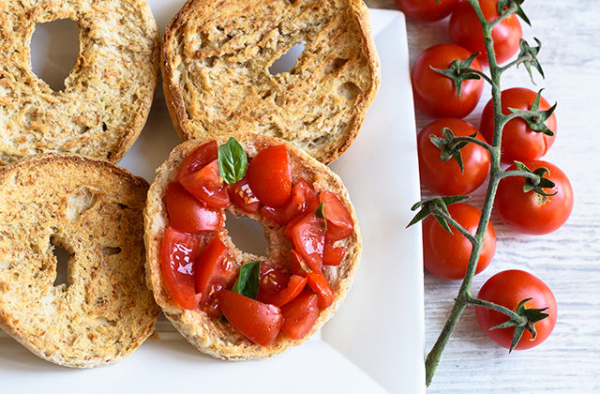Food in Puglia is a serious business; you find it everywhere and must develop a particular skill to refuse it. You’ll probably give up for two reasons: first, Apulians could take it as an offence, and second, the food will be so yummy! So, if you plan to take a trip to Puglia, just put aside your good resolutions for a few days and enjoy the show of fresh pasta, bread, focaccia, cheese, meat, fish, fruits and vegetables that this land offers. After a holiday of taralli, focaccia, bread and orecchiette, you’ll return home with a few extra pounds, but it will be worth it!
Puglia has been a crossroads of cultures and civilizations that, blending together, have created unique traditions. Greeks, Byzantines, Arabs, Swabians, Aragonese and Spaniards have influenced the architecture, the language and even the habits in the kitchen. But despite everything, Apulian cuisine is still poor, rich in genuine ingredients that result from work in the fields, sheep farming and fishing - and cooked with simple recipes.
Restaurants in Puglia, even the most famous and elegant, cook Apulian dishes. And that's the beauty of it. Before the economic boom, there was not much to eat anywhere in the country; still, the influences of the French and Bourbon noble courts and aristocratic riches, that had revolutionized the history of Piedmontese, Neapolitan or Sicilian cuisine, did not arrive here. That’s why Apulian cuisine is rich in products and flavours, essential in its elements and focused on taste.
Across the region, your indispensable travel companion is Tarallo, a baked product with an unmistakable ring shape and crumbly, crisp texture. It is made with dough from flour, water, white wine and extra virgin olive oil. You can find them everywhere, sweet and savoury, flavoured with wild fennel glazed cocoa; there is something for everyone. Be careful: one pulls the other!
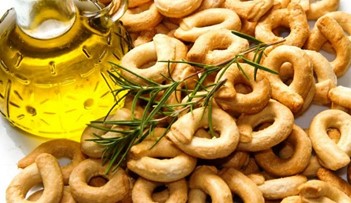
Puglia is Italy's leading region for durum wheat production. As a result, more than 100 types of bread can be found on Apulian tables, including the renowned Pane di Altamura, Europe's first DOP (Denominazione di Origine Protetta, Denomination of Protected Origin) in baked goods.
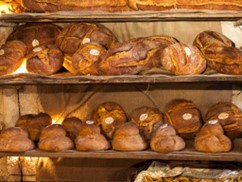
You can distinguish the bread from Altamura by its peculiar fragrance, flavour and aroma. Baked in traditional wooden and stone ovens, it has a dark, crisp crust and a soft crumb with a characteristic straw-yellow colour, a true delicacy.
The undisputed queen of summer lunches is Frisella, or Frisa, a baked product made from a special loaf of bread with a hole in it, then divided in half and made into biscuits. Softened in water, you will eat it with cherry tomatoes, oil and oregano. Simple and delicious.
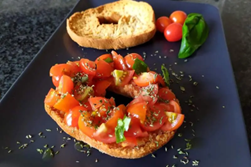
Numerous pasta shapes are also typical of this region, the most famous being Orecchiette, the true star of Apulian cuisine. With a dome shape resembling small ears, they have a rough surface and are thinner in the centre than on the edges. Even today, Apulian housewives are the custodians of a tradition that, according to some, goes back to Roman times, when there was already a similar pasta, to be eaten with cheese. According to others, they derive from the Provençal orecchiette, born between the 12th and 13th centuries, which arrived here following the Norman-Swabian domination.
The classic recipe calls for them to be kneaded on a pastry board only with durum wheat flour, warm water and salt, and to have a diameter of about 3 cm.
Orecchiette alle Cime di Rapa (Orecchiette pasta with turnip tops) is one of the symbols of Bari gastronomy and one of Italy's most famous Apulian dishes. The bitterness of the turnip tops, the anchovies' savoriness, the chilli peppers' piquant taste, and the pasta's porosity marry perfectly in a riot of scents and flavours.
Each province has its own Orecchiette: in Bari, they call them “Strascinati”, in Taranto “Chiancarelle”, in Brindisi “Stacchiodde”. In Fasano, where they cook them with green cauliflower, they make them flatter than elsewhere.
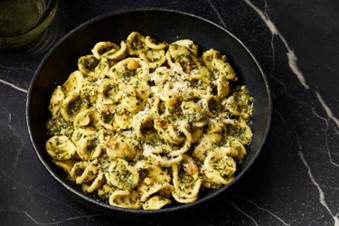
If you like cheese, tasting the local caciocavallo and mozzarella is more than "eating"; it is an authentic sensory experience. And, if you want milk to literally “explode” in your mouth, you definitely cannot miss “burrata”.
”Burrata” (from “burro”, butter in Italian) is a flask of cow's milk mozzarella dough filled with cream and shredded mozzarella. It was literally “invented” in the early 900s in Andria: local cheese makers wanted to recover mozzarella dough scraps, so they started making a wrapper with them. The filling is called “stracciatella” because the pieces of dough are “stracciati a mano” (shredded by hand) and dipped in cream. Although high in calories, it has a fresh and balanced flavour.
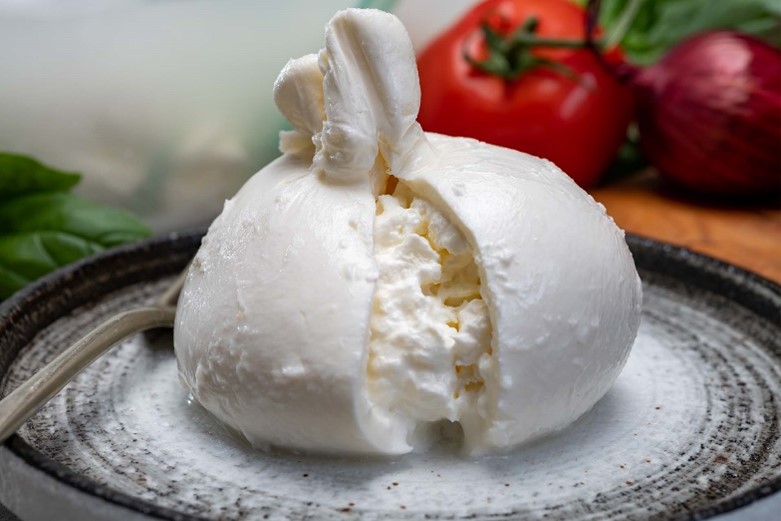
Flour, yeast, and olive oil are the ingredients of Panzerotti, fried crescents filled with tomato and mozzarella, and are ideal as an appetizer or as a snack at any time of the day. In addition to the more classic version, they can be stuffed with almost everything edible: ricotta, eggs and parsley; fried onion, tomato and ricotta forte; anchovies, black olives, capers, tomato and pecorino cheese, or meat and salami. Baked in the oven rather than fried, Panzerotti is called “Calzoni” (trousers, in Italian) ?.
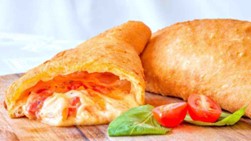
Land and sea mix harmoniously in this beautiful region, and some dishes exemplify the perfect combination of their products and flavours, with one above all, Riso, Patate e Cozze (rice, potatoes and mussels). Tasting it alone is worth the trip to Puglia. The complex preparation of this dish requires skilled hands; onions, potatoes, mussels and rice arranged in layers are baked in the oven and covered with a golden gratin crust.
Tiella Barese is a relative of Spanish paella: rice, potatoes and mussels that are placed raw in the oven, and arranged in layers in a baking dish. The difficulty of the preparation lies precisely in dosing the broth or fish stock necessary for cooking. According to “Barese” recipe, the ideal ingredients for an excellent Tiella are Tarantine mussels, yellow-fleshed potatoes cut into slices and “pomodori appesi”, tomatoes that are harvested while still yellow, joined in bunches and hung on the branch of a tree, where, with the local sun and air, they will turn red in a week.
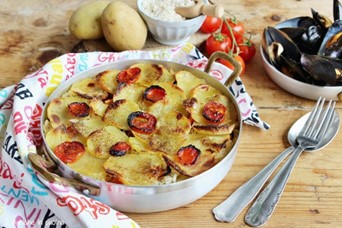
Acquasale is a traditional dish, prepared with toasted bread, the famous “friselle”. It is softened with water for a few seconds and seasoned with tomatoes, garlic, extra virgin olive oil, salt and oregano. It is a classic summer recipe rooted in the region's rural past: infact, it was the single dish eaten by the farmers who worked in the fields. Apparently, it was already known at the time of the Crusades, when the peasants of the city of Brindisi offered it to the knights as a good omen before they left for the Holy Land.
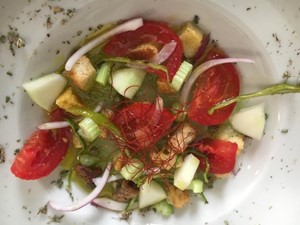
Preparing Zuppa alla Tarantina, Taranto-style soup, requires a wide variety of fish, from seafood to grouper, shrimp and cuttlefish. The fish's choice depends on the recipe but even more on what the daily fishing offers. Fish and seafood are cooked separately in oil, tomatoes, parsley and garlic sauce. Once ready, they are placed on a serving plate and served with fried bread croutons.

Cisternino is famous for its so-called "Bombette," delicious pork roulades stuffed with caciocavallo cheese, and for the quality of the meat that is prepared and sold directly in typical local butcher stores, somewhere between a bottega and a rotisserie.
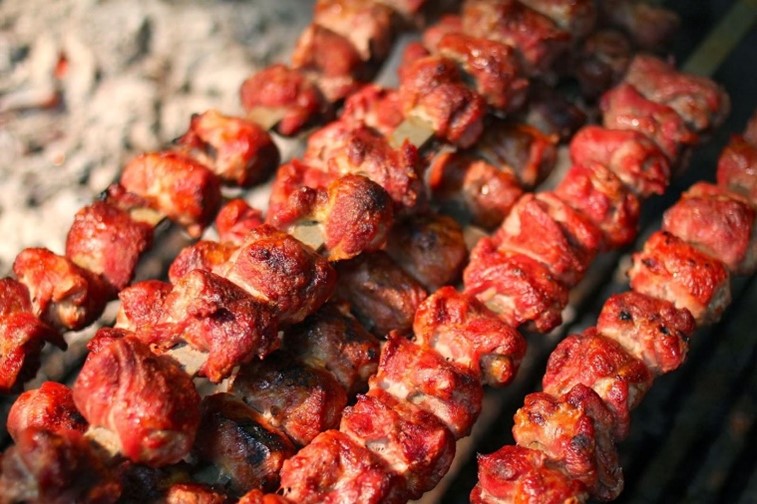
Last but not least, I can’t help but mention the olive tree, Apulian cultural heritage; there are centuries-old ones with beautiful trunks, real and natural sculptures that make the Apulian landscape unmistakable. Extra virgin olive oil is extracted from their fruits according to ancient and rigorous harvesting and pressing processes. EVO is everywhere in Apulian cuisine: don’t miss it raw on a slice of Pane di Altamura with some oregano, “pane, olio e origano”, and a nice glass of wine, you’ll grab the essence of Puglia.
And, by the way, Puglia is a land of castles, farms, and vineyards. Pugliese wine used to be shipped to France to add robustness to weak French wines. Not anymore, now the wines from Puglia have conquered the tables of the world. Primitivo, Negroamaro, Nero di Troia, Bombino Bianco, Malvasia Nera and many others make the perfect pair with the delicious dishes of Puglia, and beyond its boundaries, are appreciated for their balance between flavour and body.
As to sweets, be sure not to miss pasticciotto and Caffè Leccese, two gourmet specialities from Lecce. Leccese coffee is iced with almond milk, typical of Salento, while pasticciotto is a crumbly shortbread shell filled with custard. It is said to have originated from the ingenuity of a pastry chef in the 1700s, who, not having enough ingredients for an entire cake, decided to make a smaller but delicious dessert. You will find it in all bars and pastry shops, not only at breakfast but whenever you want to indulge in a sin of gluttony!
I am sure the trip to Puglia will always remain in your heart, not only for the delicacies you’ll eat, simple dishes prepared with love and respect for ancient traditions, but especially for the warmth and hospitality of its inhabitants, who will make you feel at home. Good food, good people and beautiful land and sea, what else do we need to be happy?
Ciao da Marcello
